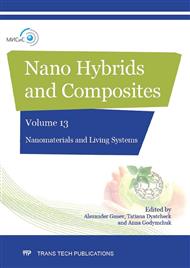[1]
M.J. Lü, J. Li, X.Y. Yang, C.A. Zhang, J. Yang, H. Hu, X.B. Wang, Applications of graphene-based materials in environmental protection and detection, Chin. Sci. Bull. 58 (2013) 2698-2710.
DOI: 10.1007/s11434-013-5887-y
Google Scholar
[2]
K.P. Loh, Q. Bao, G. Eda, M. Chhowalla, Graphene oxide as a chemically tunable platform for optical applications, Nat. Chem. 2 (2010) 1015-1024.
DOI: 10.1038/nchem.907
Google Scholar
[3]
W.Q. Wu, Y. Yang, H.H. Zhou, T.T. Ye, Y.Z. Huang, R. Liu, F.Y. Kuang, Highly efficient removal of Cu(II) from aqueous solution by using graphene oxide, Water Air Soil Poll. 224 (2013) 1372-1380.
DOI: 10.1007/s11270-012-1372-5
Google Scholar
[4]
Z.H. Huang, X. Zheng, W. Lv, M. Wang, Q.H. Yang, F. Kang, Adsorption of lead (II) ions from aqueous solution on low-temperature exfoliated graphene nanosheets, Langmuir 27 (2011) 7558-7562.
DOI: 10.1021/la200606r
Google Scholar
[5]
G. Zhao, J. Li, X. Ren, C. Chen, X. Wang, Few-layered graphene oxide nanosheets as superior sorbents for heavy metal ion pollution management, Environ. Sci. Technol. 45 (2011) 10454-10462.
DOI: 10.1021/es203439v
Google Scholar
[6]
R. Sitko, E. Turek, B. Zawisza, E. Malicka, E. Talik, J. Heimann, A. Gagor, B. Feist, R. Wrzalik, Adsorption of divalent metal ions from aqueous solutions using graphene oxide, Dalton Trans. 45 (2013) 5682-5689.
DOI: 10.1039/c3dt33097d
Google Scholar
[7]
A. Yu. Romanchuk, A.S. Slesarev, S.N. Kalmykov, D.V. Kosynkin, J.M. Tour, Graphene oxide for effective radionuclide removal, Phys. Chem. Chem. Phys. 15 (2013) 2321-2327.
DOI: 10.1039/c2cp44593j
Google Scholar
[8]
Y. Li, P. Zhang, Q. Du, X. Peng, T. Liu, Z. Wang, Y. Xia, W. Zhang, K. Wang, H. Zhu, D. Wu, Adsorption of fluoride from aqueous solution by graphene, J. Colloid Interface Sci. 363 (2011) 348-354.
DOI: 10.1016/j.jcis.2011.07.032
Google Scholar
[9]
H. Gao, Y. Sun, J. Zhou, R. Xu, H. Duan, Mussel-inspired synthesis of polydopamine-functionalized graphene hydrogel as reusable adsorbents for water purification, ACS Appl. Mater. Inter. 5 (2012) 425-432.
DOI: 10.1021/am302500v
Google Scholar
[10]
L. Hao, H. Song, L. Zhang, X. Wan, Y. Tang, Y. Lv, SiO2/graphene composite for highly selective adsorption of Pb(II) ion, J. Colloid Interf. Sci. 369 (2012) 381-387.
DOI: 10.1016/j.jcis.2011.12.023
Google Scholar
[11]
L. Liu, C. Li, C. Bao, Q. Jia, P. Xiao, X. Liu, Q. Zhang, Preparation and characterization of chitosan/graphene oxide composites for the adsorption of Au(III) and Pd(II), Talanta 93 (2012) 350-357.
DOI: 10.1016/j.talanta.2012.02.051
Google Scholar
[12]
L. Fan, C. Luo, M. Sun, X. Li, H. Qiu, Highly selective adsorption of lead ions by water-dispersible magnetic chitosan/graphene oxide composites, Colloids Surf. B. 103 (2013) 523-529.
DOI: 10.1016/j.colsurfb.2012.11.006
Google Scholar
[13]
Information on http: /www. who. int/ipcs/features/lead. pdf.
Google Scholar
[14]
L. Järup, Hazards of heavy metal contamination, Br. Med. Bull. 68 (2003) 167-182.
Google Scholar
[15]
A.V. Melezhyk, A.G. Tkachev, Synthesis of graphene nanoplatelets from peroxosulfate graphite intercalation compounds, Nanosyst. Phys. Chem. Math. 5 (2014) 294-306.
Google Scholar
[16]
Y. Zhu, S. Murali, W. Cai, X. Li, J.W. Suk, J.R. Potts, R.S. Ruoff, Graphene and graphene oxide: synthesis, properties, and applications, Adv. Mater. 22 (2010) 3906-3924.
DOI: 10.1002/adma.201001068
Google Scholar
[17]
M.M. Rao, D.K. Ramana, K. Seshaiah, M.C. Wang, S.W.C. Chien, Removal of some metal ions by activated carbon prepared from Phaseolus aureus hulls, J. Hazard. Mater. 166 (2009) 1006-1013.
DOI: 10.1016/j.jhazmat.2008.12.002
Google Scholar
[18]
S. Wang, Y. Dong, M. He, L. Chen, X. Yu, Characterization of GMZ bentonite and its application in the adsorption of Pb (II) from aqueous solutions, Appl. Clay Sci. 43 (2009) 164-171.
DOI: 10.1016/j.clay.2008.07.028
Google Scholar
[19]
D. Xu, X. Tan, C. Chen, X. Wang, Removal of Pb(II) from aqueous solution by oxidized multiwalled carbon nanotubes, J. Hazard. Mater. 154 (2008) 407-416.
DOI: 10.1016/j.jhazmat.2007.10.059
Google Scholar
[20]
X. Deng, L. Lu, H. Li, F. Luo, The adsorption properties of Pb (II) and Cd (II) on functionalized graphene prepared by electrolysis method, J. Hazard. Mater. 183 (2010) 923-930.
DOI: 10.1016/j.jhazmat.2010.07.117
Google Scholar


